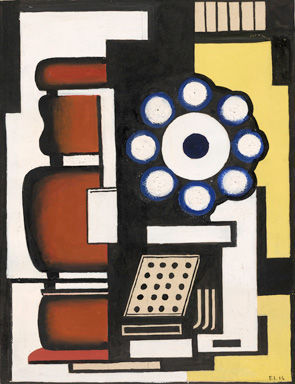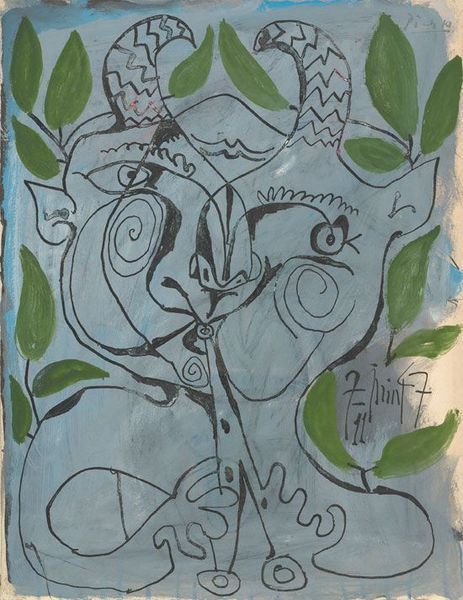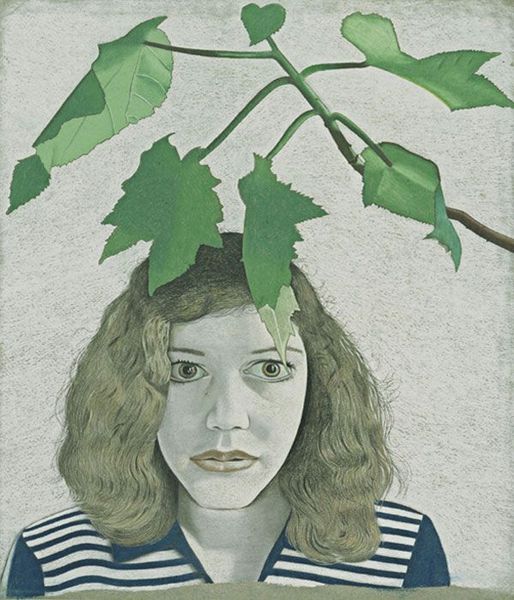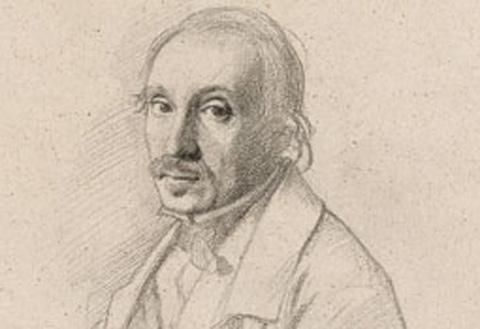Art Institute of Chicago receives nearly 1,000 works of art in single gift from Dorothy Braude Edinburg
Fernand Léger, Study for The Ball Bearing, 1926. Gift of Dorothy Braude Edinburg to the Harry B. and Bessie K. Braude Memorial Collection. (c) 2013 Artists Rights Society (ARS), New York/ADAGP, Paris.
CHICAGO, IL.- The Art Institute of Chicago announced a major gift from Massachusetts collector Dorothy Braude Edinburg. The gift, one of the most significant in the museum’s history, is composed of nearly 800 works on paper—primarily European prints and drawings from Old Master to modern—and 150 works from China, Korea, and Japan, including stonewares, porcelains, and printed books. These works join Mrs. Edinburg’s long-term loans and prior gifts to the Art Institute, constituted by Japanese and Chinese ceramics and more than 100 extraordinary works by such artists as Vincent van Gogh, Paul Gauguin, Pablo Picasso, and Henri Matisse. All of these gifts are part of the Harry B. and Bessie K. Braude Memorial Collection, named by Mrs. Edinburg in honor of her parents.
“We have been privileged by our relationship with Dorothy Braude Edinburg since 1991, when she wrote the museum an almost unnervingly straightforward letter of introduction,” said Douglas Druick, President and Eloise W. Martin Director of the Art Institute. “Since that time, her singular goal has not changed: memorializing her parents, who instilled and nurtured in her a love of art and collecting, by ensuring that her collection, and theirs, would eventually be a public resource that would inspire others as she herself has been inspired. We have had the good fortune to have her entire collection on long-term loan for some time, and we are thrilled now to receive this extraordinarily generous gift, reflective of her collaborative spirit and innate sense of curiosity. It is an energizing force for the museum, and we are proud to be the institution that sustains the legacy of her family."
“I have never thought of my collection as a personal endeavor,” said Dorothy Braude Edinburg. “Rather, I have always believed that it should ultimately enter a major museum and serve a broad public. For many years I have watched the Art Institute actively cultivate not only visitors and audiences but also donors who would entrust the care of their collections to the museum, and I admire the way the Art Institute has consistently been building relationships on both sides. And working with curators at the Art Institute who share my passion has been, and will continue to be, intellectually stimulating, mutually rewarding, and even fun. I have seen the Art Institute as the eventual home for my entire collection for many years, and I am thrilled to be taking another step forward with this gift in honor of my parents". Mrs. Edinburg’s most recent contribution to the Harry B. and Bessie K. Braude Memorial Collection at the Art Institute is composed of works in several distinct areas: European prints and drawings, Chinese and Korean stonewares and porcelains, and Japanese printed books. In Japanese art, Edinburg’s gift includes more than 45 volumes of extreme rarity and quality, many of them prevalent in Edo-period Japan but virtually nonexistent in American museum collections. Perhaps the single most important volume in the collection is the extremely rare Soken sekisatsu of 1768 by Ito Jakuchu, one of the most celebrated Kyoto painters, who also experimented with printing techniques.
Edinburg’s gift of 88 Chinese and 15 Korean stonewares and porcelains displays her admirable eye for what collectors have traditionally esteemed as “scholar’s taste” in ceramics—vessels whose beauty derives from the integration of lustrous monochrome glaze, restrained decoration, and elegant form. Highlights of the collection include celadons dating from the 12th and 13th centuries, together with their beautifully innovative counterparts in Korea. Together, these illustrate some of the finest developments in China’s oldest ceramic tradition. Also included are a variety of Chinese whitewares, the rarest of which date to the 10th century and complement the Art Institute’s rich holdings of the 11th and 12th centuries that mark the emergence of the world’s first true porcelain. Contrasting with these are several handsome brown- and black-glazed wares, the most elegant of which were inspired by lustrous black lacquer.
The majority of the gift consists of works on paper, including more than 613 prints and 190 drawings ranging from Old Master works to those by John Constable, Edgar Degas, Claude Monet, Juan Gris, Vasily Kandinsky, Edvard Munch, Henri Matisse, and Pablo Picasso. One of the most significant of the older works is Federico Zuccaro’s Coronation of the Virgin (c. 1570), which was purchased by Edinburg at the first Chatsworth auction of the Duke of Devonshire’s collection in 1984 and is now considered the most important drawing by the artist in any North American collection.
Represented in the collection are works by a broad range of modern artists—from Édouard Manet to José Clemente Orozco and from James McNeill Whistler to Kurt Schwitters—including a very rare, heavily worked charcoal drawing by Gustave Courbet, The Woodcutters (1860). Among the most remarkable works are: Camille Pissarro’s early pastel, At the Window, Rue des Trois Frères (1878), created when Pissarro was experimenting with different media and formats with the possible intent of finding alternative markets for selling his art; early studies after the model by Manet and Cézanne; seven drawings and pastels by Degas spanning his career; Otto Dix’s portrait of a female prostitute beyond her prime, Old Woman (c. 1923); and Piet Mondrian’s Study for a Composition (1940/41), the only known surviving study by Mondrian with colored collage elements, making it a singularly rare example of the artist’s methods, and, in its use of collage, an anticipation of his eventual fusing of color and line that would prove to be a defining moment in his career.
This addition to the Harry B. and Bessie K. Braude Memorial Collection is a landmark gift to the Art Institute that resonates throughout the institution, allowing for a deeper artistic dialogue across the entirety of the museum’s permanent collection. In breadth and scope, the gift from Dorothy Braude Edinburg is a foundational contribution to the museum.
Edgar Degas, Plowed Field Bordered by Trees, c. 1892. Gift of Dorothy Braude Edinburg to the Harry B. and Bessie K. Braude Memorial Collection.
Pablo Picasso. The Faun Musician, 1947. The Art Institute of Chicago, gift of Dorothy Braude Edinburg to the Harry B. and Bessie K. Braude Memorial Collection. © 2013 Estate of Pablo Picasso / Artists Rights Society (ARS), New York
Lucian Freud, Girl with Fig Leaf, 1947, Etching, Plate: 11 13/16 x 9 3/8" (30 x 23.8 cm), Sheet: 17 11/16 x 12 9/16"), Publisher: London Gallery, London, Printer: unknown, Paris, Edition: 10, The Art Institute of Chicago. Dorothy Braude Edinburg Collection in honor of Harry B. and Bessie K. Braude, 1991.616, © 2007 Lucian Freud.
Edgar Degas. Auguste de Gas (detail), c. 1859. Gift of Dorothy Braude Edinburg to the Harry B. and Bessie K. Braude Memorial Collection.

/https%3A%2F%2Fprofilepics.canalblog.com%2Fprofilepics%2F1%2F0%2F100183.jpg)
/https%3A%2F%2Fstorage.canalblog.com%2F03%2F02%2F119589%2F96711876_o.jpg)
/https%3A%2F%2Fstorage.canalblog.com%2F11%2F31%2F119589%2F94773502_o.jpg)
/https%3A%2F%2Fstorage.canalblog.com%2F20%2F83%2F119589%2F94772815_o.jpg)
/https%3A%2F%2Fstorage.canalblog.com%2F26%2F72%2F119589%2F75604929_o.jpg)
/https%3A%2F%2Fstorage.canalblog.com%2F59%2F60%2F119589%2F26458628_o.jpg)







/http%3A%2F%2Fstorage.canalblog.com%2F62%2F17%2F119589%2F127198849_o.jpg)
/http%3A%2F%2Fstorage.canalblog.com%2F66%2F66%2F119589%2F127181870_o.jpg)
/http%3A%2F%2Fstorage.canalblog.com%2F24%2F61%2F119589%2F110144822_o.jpg)
/http%3A%2F%2Fstorage.canalblog.com%2F16%2F34%2F119589%2F93653822_o.jpg)